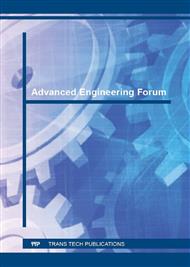[1]
WILLIAMS M.L., «On the stress distribution at the base of stationary crack», J. of Appl. Mectr, 1957, Vol. 24, pp.109-4.
Google Scholar
[2]
Cotterell, B., 1970. On fracture path stability in compact tension test. International Journal of Fracture Mechanics 6 (2), 189–192.
DOI: 10.1007/bf00189826
Google Scholar
[3]
H. Adib, G. Pluvinage. 2003, Theoretical and numerical aspects of the volumetric approach for fatigue life prediction in notched components. International Journal of fatigue 25 67-76.
DOI: 10.1016/s0142-1123(02)00040-3
Google Scholar
[4]
Guy Pluvinage, Joseph Gilgert, 2003, Fracture emanating from stress concentrators in materials: links with classical fracture mechanics. Materiali in Tehnologue 37 3-4, MTAEC9, 37[3-4]117(2003).
Google Scholar
[5]
Vratnica M, Pluvinage G, Jodin P, Cvijovic Z, Rakin M, Burzic Z, 2010 , Influence of notch radius and microstructure on the fracture behavior of Al–Zn–Mg–Cu alloys of different purity'. Materials and Design 31 1790–1798.
DOI: 10.1016/j.matdes.2009.11.018
Google Scholar
[6]
Richard, H.A., Benitz, K. (1983). International Journal of Fracture 22, R55-R58.
Google Scholar
[7]
Schillig, R. (1990). Ein Beitrag zur Ermüdungsrissausbreitung bei gleichphasiger Mixed-Mode Belastung. Fortschr. -Ber. VDI Reihe 18 Nr. 86, Düsseldorf: VDI Verlag.
Google Scholar
[8]
Zhu XK, Leis BN. Fracture resistance curve testing of X-80 pipeline steel using SENB specimen and normalization method , j. of pipeline engineering 2008; 7: 126-136.
Google Scholar
[9]
Pavankumar TV, Chattopadhyay j, Dutta, BK, Kushwaha HS. Transferability of specimen J- R curve to straight pipes with throughwall circumferential flaws, International J, Pressure Vessels and pipes 2002; 79: 127-134.
DOI: 10.1016/s0308-0161(01)00134-x
Google Scholar
[10]
Tanaka K. Fatigue crack propagation from a crack inclined to the cyclic tensile axis.
Google Scholar
[11]
Brown MW., Miller KJ. Initiation and growth of cracks in biaxial fatigue. Fatigue and Fracture of Engineering Materials and Structures, 1979, 1, pp.231-246.
DOI: 10.1111/j.1460-2695.1979.tb00380.x
Google Scholar
[12]
Chen W.R., Keer L.M. Fatigue crack growth in mixed mode loading. Transaction ASME Journal of Engineering Materials and Technology, 1991, 7, pp.41-47.
Google Scholar
[13]
Ueda Y., Ikeda K., Yao T., Aoki M. Characteristics of brittle fracture under general combined modes including those under biaxial tensile loads. Engineering Fracture Mechanics, 1983, 18, pp.1133-1158.
DOI: 10.1016/0013-7944(83)90007-3
Google Scholar
[14]
Jeng Y.S., Shah S.P. Mixed-mode fracture of concrete. International Journal of Fracture, 1988, 38, pp.123-142.
Google Scholar
[15]
Williams, J.G. and Ewing, P.D. (1972). Fracture under complex stress – the angled crack problem. International Journal of Fracture 8, 441–446.
DOI: 10.1007/bf00191106
Google Scholar


